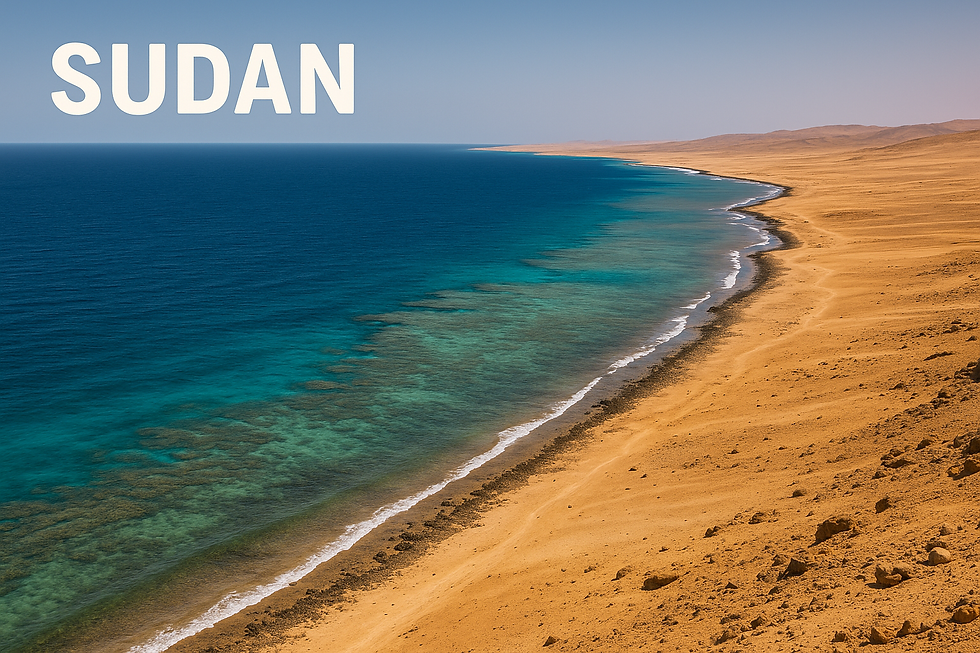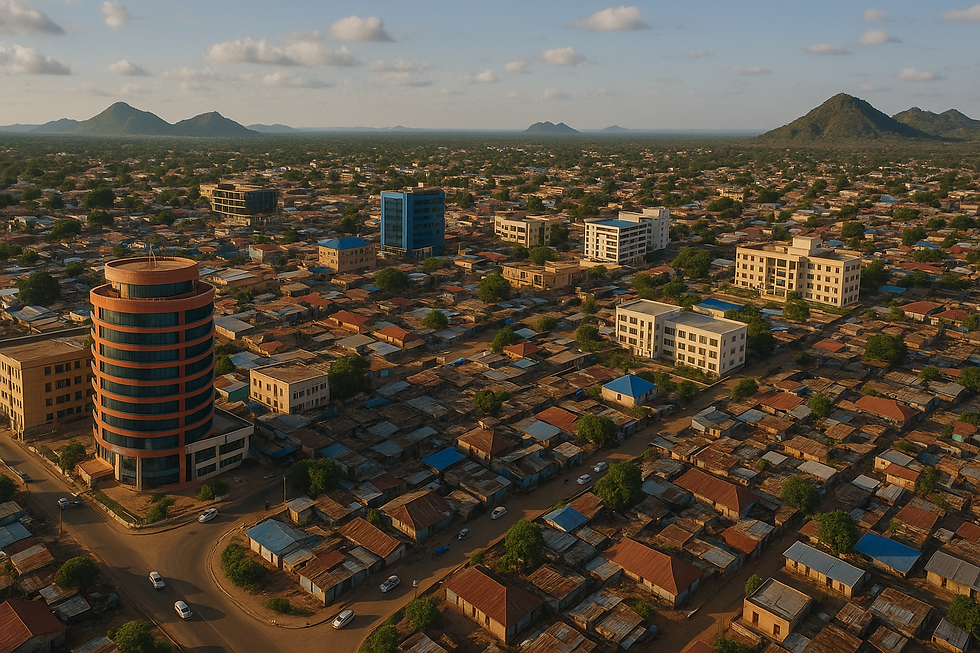Ashes and Adaptation: Sudan’s ESG Reckoning in a Time of Conflict, Collapse, and Climate Extremes
- tinchichan

- Aug 8
- 5 min read
It’s been over a year since Khartoum fell to chaos. Once a city of poets, pyramids, and the promise of democratic transition, Sudan is now a nation torn by civil war, displaced by climate, and disfigured by the weight of militarized governance and ecological decay. But even in this fog of conflict, something deeper stirs beneath the surface: a reckoning with sustainability—not as a trend, but as a matter of survival.
Sudan is not an ESG darling. It is a cautionary tale. A country where decades of authoritarian rule, economic volatility, and environmental degradation have converged into a perfect storm. Yet among burned villages and broken ministries, communities are building resilience from the ground up—through water cooperatives, reforestation brigades, and a quiet reimagining of what sustainability could mean in a collapsed state.

“We no longer speak of long-term development,” says a Sudanese climate researcher now based in Nairobi. “We speak of protection. Of dignity. Of survival. If ESG can exist in Sudan, it must first serve those who have nothing left but the land beneath their feet.”
1. ESG in Context: A Nation in Ruin, a People in Flight
GDP (2024 est.): ~$30 billion (nominal)
Population: ~48 million
GDP per capita: ~$620
Poverty rate: ~55% (and rising)
Inflation (2024 est.): >200%
Displaced persons: >10 million (5M internally, 5M across borders)
Armed conflict: RSF vs Sudanese Armed Forces since April 2023
Sudan is:
A failed state with no unified government
Africa’s 3rd largest country by land, rich in resources but impoverished in governance
Facing the biggest humanitarian crisis of 2024, according to UN OCHA
A place where climate change, war, and governance collapse form a three-headed hydra
There are no ESG indices here. No stock exchange. No green bonds. But there are ecosystems, communities, and futures worth defending—which is where ESG must begin.
2. Environmental Sustainability: The Sahel Burns, the Nile Shrinks
2.1 Climate Fragility and Ecological Collapse
Sudan is one of the most climate-vulnerable nations on Earth:
Rising temperatures outpacing global averages
Rainfall decline of 20–30% in key agricultural zones (Kordofan, Darfur)
Desertification advancing southward by 100km per decade
Nile water disputes intensifying with Ethiopia’s Grand Renaissance Dam (GERD)
Disasters:
Flash floods displace tens of thousands annually, especially in Gezira and Kassala
Dust storms (haboobs) increasing in frequency, affecting air quality and crops
Forest loss (+ charcoal trade) accelerating in conflict-affected regions
Sudan’s updated NDC (2021)—now largely defunct—committed to:
35% GHG reduction by 2030, conditional on international finance
Focus on: agriculture, water, energy, forestry, and early warning systems
Financing required: $12.9 billion, 90% dependent on external aid
2.2 Energy and Natural Resource Challenges
Energy landscape:
~60% of Sudan’s energy comes from biomass (wood, charcoal)
National electrification rate: ~40%
Hydropower (Merowe Dam) contributes ~30%, but is vulnerable to drought and sabotage
No functioning national energy policy since 2021
Emerging potential:
Abundant solar irradiation across the northern and eastern deserts
Wind corridors identified in Red Sea state
Gold and oil reserves—often fueling conflict, not development
Barriers:
Infrastructure destroyed or inaccessible
Decentralized militias extorting or blocking energy projects
No investment climate or regulatory agency functioning since mid-2023
3. Social Sustainability: Displacement, Dignity, and the Social Fabric Torn
3.1 Human Development in Freefall
HDI: 0.510 (2023) – among the lowest globally
Life expectancy: ~63 years
Literacy: ~61%, lower among women and rural youth
School attendance: collapsed in many regions due to war and displacement
Social indicators:
Hospitals looted or destroyed in Khartoum, El Geneina, and Nyala
Maternal mortality among the highest in the world
Food insecurity: ~18 million in crisis or worse (IPC Phase 3+)
Over 7,000 schools non-functional due to occupation or damage
3.2 Gender, Refugees, and the Social Compact
Women and girls:
Systemic sexual violence used as a weapon of war
Girls’ education interrupted in most conflict zones
Women’s cooperatives in farming and water management remain critical to survival
Displacement:
Over 10 million displaced, many multiple times
Largest refugee flows into Chad, South Sudan, Egypt, Ethiopia
Camps becoming permanent climate-exposed settlements
Social resilience:
Faith-based groups, tribal elders, and local NGOs fill governance voids
Informal solidarity networks coordinate water, food, and protection
Diaspora sending $1–1.5 billion/year in remittances, often via hawala or mobile money
4. Governance: Collapse, Contestation, and the ESG Vacuum
4.1 Institutional Disintegration
There is no unified government of Sudan:
Sudan Armed Forces (SAF) control parts of the east and north
Rapid Support Forces (RSF) control much of Darfur and Khartoum
Civilian authorities in exile (Forces for Freedom and Change, Resistance Committees)
UN mediation efforts stalled, African Union sidelined
Corruption and ESG:
Sudan ranks 172/180 on Transparency International’s CPI (2023)
Resources (gold, oil, timber) often extracted illegally or by warlords
No functioning judiciary, regulatory bodies, or planning ministries
4.2 ESG Regulation and Informal Systems
There is no formal ESG framework in Sudan. But:
Local cooperatives track water access, reforestation, and gender inclusion
NGOs and UN agencies use SDG-aligned metrics in project monitoring
Some rebel-held zones have proto-governance systems regulating land and forest use
Examples:
In South Kordofan, farmer unions document climate resilience indicators
In Darfur, women-led councils manage peace gardens and seed banks
In eastern refugee camps, community groups co-manage solar water pumps
5. ESG Finance: Humanitarian First, Climate Second
5.1 Humanitarian-Climate Nexus
Sudan receives billions in humanitarian aid, but only a fraction for climate resilience:
2024 UN appeal: $2.6 billion, only 38% funded
GCF readiness programs suspended due to governance breakdown
World Bank, AfDB, and IMF paused all programs since 2023
Key actors now:
ICRC, WFP, UNDP, FAO, OCHA, CARE, NRC
Focus on cash-for-resilience, reforestation, and emergency water systems
Some climate-smart agriculture pilots continue in safe zones (e.g., Blue Nile)
5.2 Remittances, Informal ESG, and Diaspora Capital
Remittances = Sudan’s largest source of foreign exchange
Diaspora funds schools, clinics, local solar kits—often bypassing formal channels
Islamic finance and waqf (charitable foundations) fund some ESG-like projects
Innovation:
Mobile money used for climate-insurance pilots in refugee camps
Community groups issuing impact reports to international donors
Youth-led tech collectives mapping deforestation and climate risk via satellite
6. ESG Case Studies: Sudan in Fragmented Motion
Case Study 1: Women’s Reforestation Brigades (North Darfur)
Local women planting acacia and moringa trees for soil restoration
Trees used for food, fuel, and erosion control
Funded by diaspora remittances and small UN grants
Governance provided by informal village councils
Case Study 2: Solar Water Cooperatives (Blue Nile State)
Solar pumps installed by NGOs, maintained by local youth
Water shared across ethnic and tribal lines to reduce conflict
Cooperatives tracking usage, rainfall, and recharge rates
Case Study 3: Peace Gardens in Displacement Camps
Communal gardens in refugee camps (e.g., White Nile)
Provide food, income, trauma healing
Managed by women, supported by FAO and UN Women
ESG indicators include nutrition, income, social cohesion
7. Comparative ESG Snapshot: Fragile States (Africa)
Indicator (2023) | Sudan | South Sudan | Somalia | CAR | Eritrea |
GHG per capita (tCO₂e) | ~0.3 | ~0.2 | ~0.1 | ~0.2 | ~0.2 |
Renewable electricity (%) | ~40% | ~12% | ~30% | ~15% | ~50% |
ESG regulation | None | None | None | None | No data |
Sovereign green bond issued | No | No | No | No | No |
TI Corruption Rank (2023) | 172/180 | 178 | 175 | 157 | No data |
*Sudan sits at the bottom of the ESG pyramid—but holds enormous potential for resilience-based, justice-centered ESG innovation.
8. Strategic ESG Risks and Opportunities
Risks
Active conflict and displacement
Environmental degradation fueling further violence
Total breakdown of institutions
Donor fatigue and lack of oversight
Opportunities
Scale community-based climate adaptation in safe zones
Channel diaspora and Islamic finance into ESG-aligned impact projects
Integrate ESG metrics into humanitarian programming
Support women-led environmental governance
Prepare for post-conflict green reconstruction anchored in just transition principles
Conclusion: A Nation in Ashes, A People Still Planting
Sudan is not an ESG market. It is an ESG mirror—reflecting the limits of global frameworks that cannot yet reach the places most in need of sustainability, justice, and peace.
And yet, among the ruins, Sudanese communities are building the future with their hands, their seeds, and their hope. If ESG is to mean anything in the 21st century, it must mean something here.



תגובות